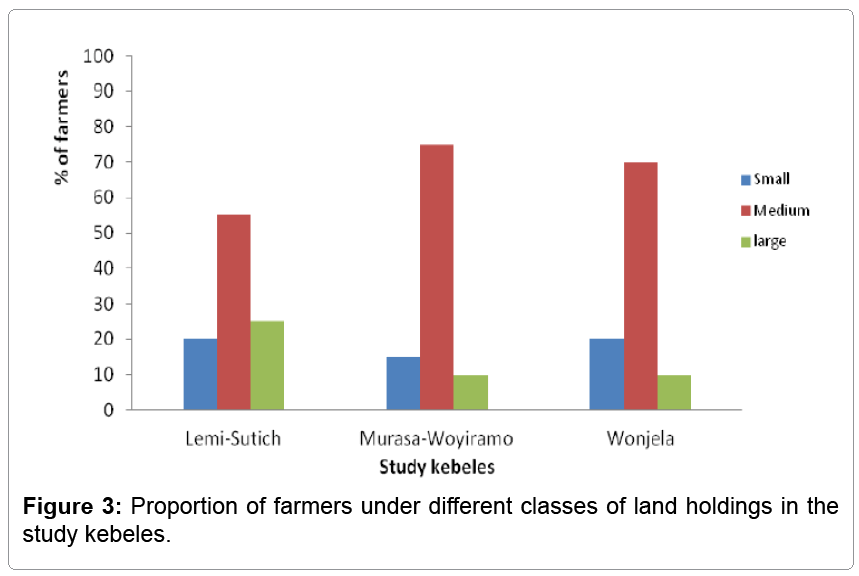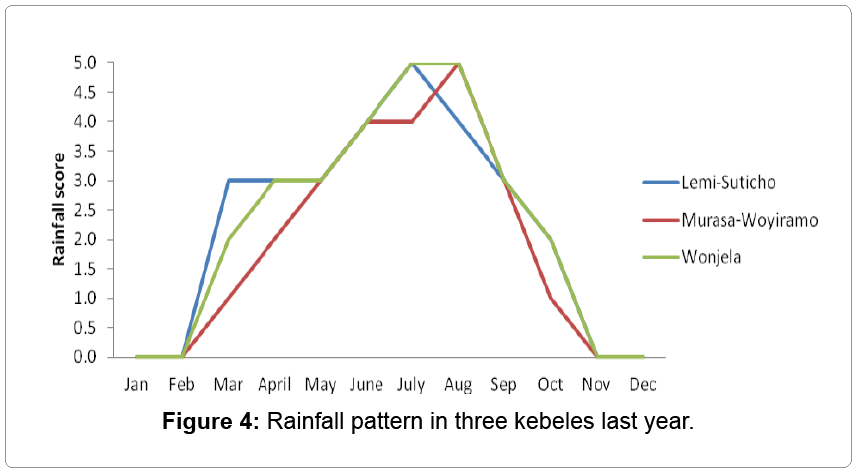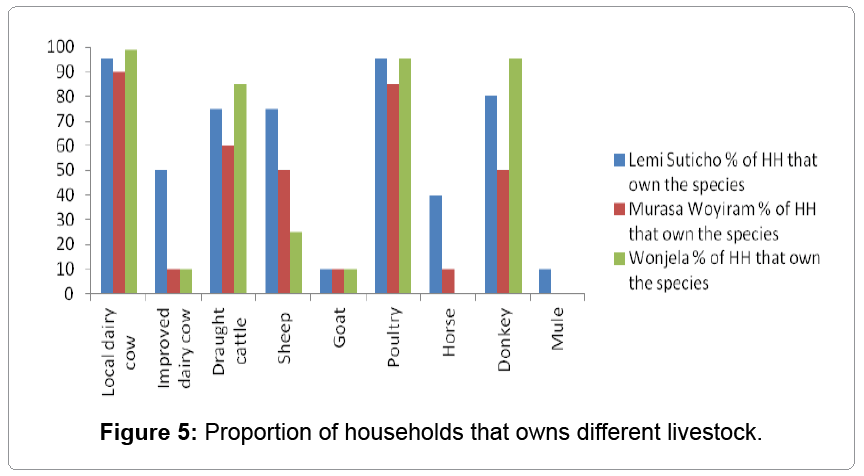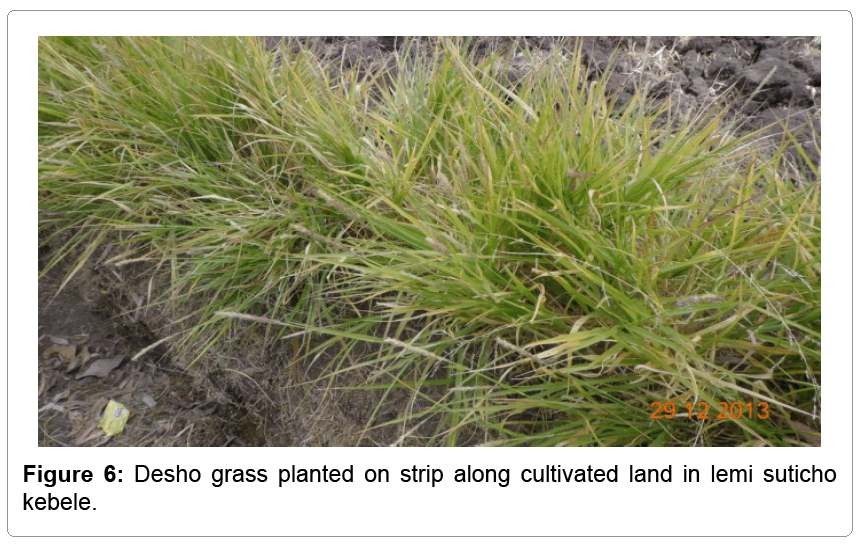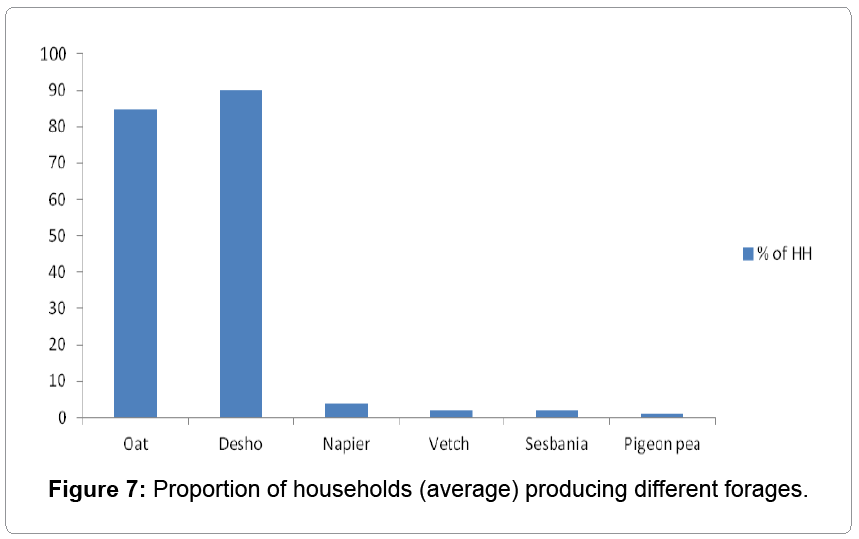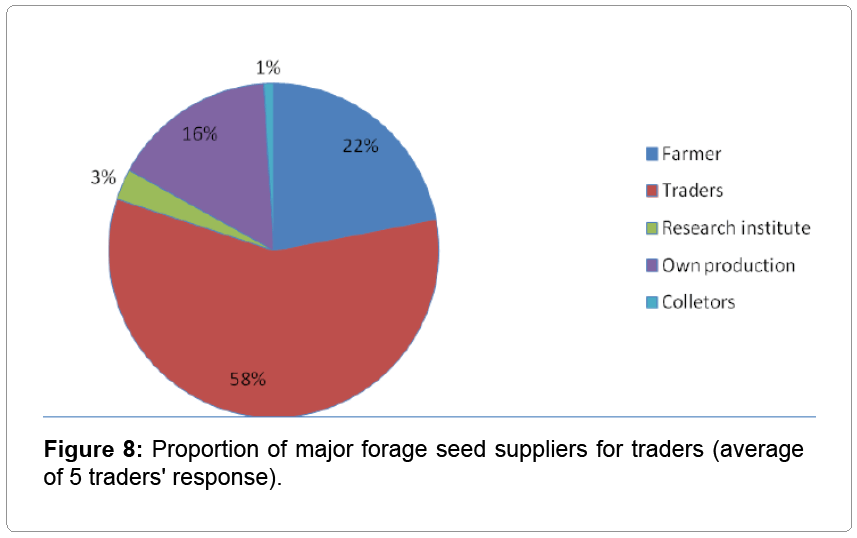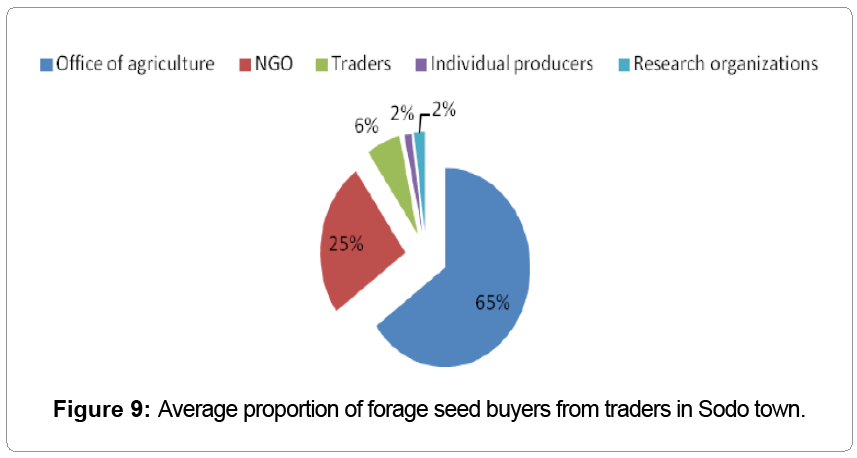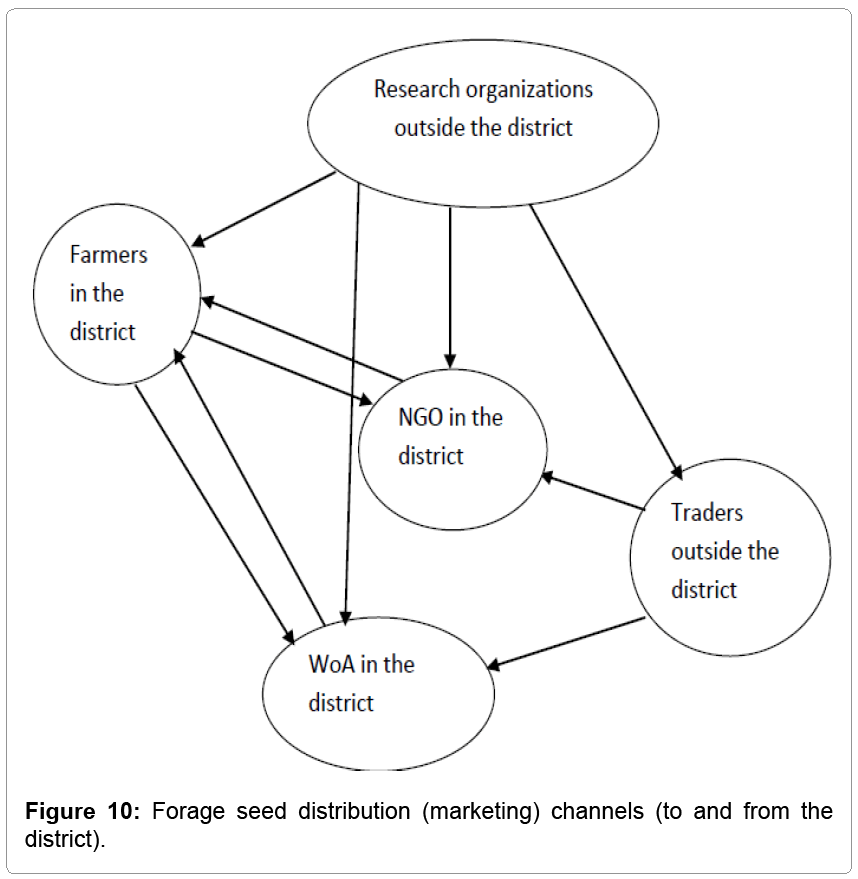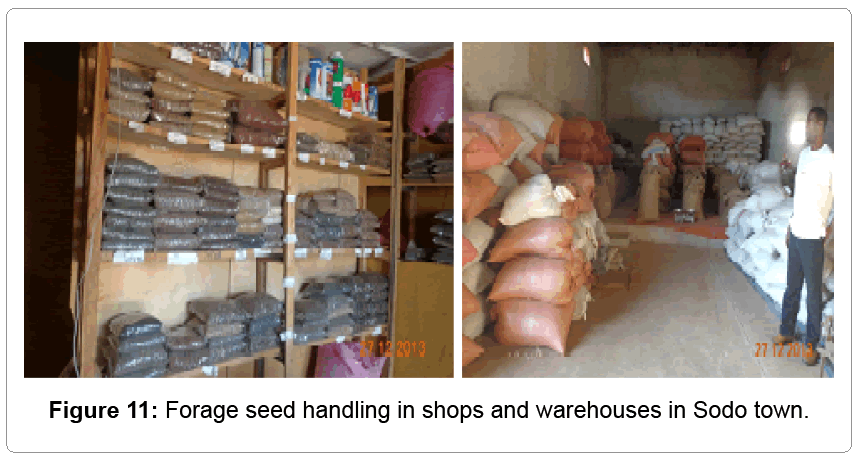Research Article Open Access
Rapid Assessment on Status of Forage Seed Production and Marketing in Doyogena District of Kembata-Tembaro Zone, SNNPR, Ethiopia
Mengistu S, Abiso S, Tessema SWF, Tera A and Bassa Z*Southern Agricultural Research Institute, Areka Agricultral Research Center, Areka, Ethiopia
- *Corresponding Author:
- Bassa Z
Southern Agricultural Research Institute
Areka Agricultral Research Center
P. O. Box 79, Areka, Ethiopia
Tel: 25146555201125
E-mail: bassazekarias@yahoo.com
Received Date: February 01, 2016; Accepted Date: February 17, 2016; Published Date: March 07, 2016
Citation: Mengistu S, Abiso S, Tessema SWF, Tera A, Bassa Z (2016) Rapid Assessment on Status of Forage Seed Production and Marketing in Doyogena District of Kembata-Tembaro Zone, SNNPR, Ethiopia. J Fisheries Livest Prod 4:171. doi: 10.4172/2332-2608.1000171
Copyright: © 2016 Mengistu S, et al. This is an open-access article distributed under the terms of the Creative Commons Attribution License, which permits unrestricted use, distribution, and reproduction in any medium, provided the original author and source are credited.
Visit for more related articles at Journal of Fisheries & Livestock Production
Abstract
Livestock production is one of the main economic activities that used for income earning, food security and human welfare improvement sector in Southern Nations Nationalities and Regional States of Ethiopia. However, its productivity is poor due to low adoption and utilization of improved forages and forage seed production, awareness problem, erratic rain fall and related constraints. The purpose of this study was therefore to assess the status and constraints of forage seed production and marketing and to review the technical and institutional bottlenecks of the sector in Doyogena district. The study was conducted by using checklist. The study used key informant interview and Focus group discussion in accordance with secondary data collected from Woreda agricultural offices and Literature review. The study confirmed that in addition to its feed and soil and water conservation value, improved forage and forage seed becomes a very expensive income source for most traders and traders in the district. Farmers in the area have difficulty to access new and high yielding forage varieties to attain more stable forage production and productivity. Although, different forage species like oat, vetch, Napier grass, Desho grass, tree Lucerne, sesbania, pigeon pea and lablab have been distributed to some farmers in the district by governmental and nongovernmental organizations, the adoption intensity and utilization is very low except Desho grass, which is widely distributed in the region. Desho grass is very well known by farmers for its fodder, cash and conservation value as compared to other forage species. That is why Desho grass is best adopted forage in the district and in the region at large. The farmers have no or limited knowledge and experience on improved forage varieties and production. Capacity building and extension system on forage technology packages is very weak. Moreover, forage seed distribution and monitoring systems employed by different development practitioner is poor. Land shortage, poor knowledge on how to integrate forages with other farming system, shortage of seed supply and lack of proper forage seed marketing system aggravate the problem on forage production and productivity in the district. On the other hand, there are forage seed traders from other districts who buy and sell seed of different forage varieties. These traders are collecting different forage seeds from other regions in the country. If they would have better seed source in the region, they could be able to avoid high transportation cost from long distances. There is no direct linkage of farmers in the district with any forage seed traders. It is through government organizations and NGOs that farmers are getting forage seeds/planting material. Undertaking similar studies in determinants of improved forage adoption and seed production is believed to boost the sectors productivity. Forage seed Traders in Wolaita Soddo used majorly other traders as source of seed for sale (60%) this indicates that market structure for the commodity of non competitive type. This non competitive behavior of forge market structure hinders productivity of the sector and it is an implication of market inefficient. Taking in to account the great interest of farmers for change, there is a need to strengthen the capacity development and forage technology extension system in the district. Integrating high yielding and high value forage crops with other food crops also need to be given strong attention by both governmental and non-governmental organizations. Establishing forage seed producer groups may have significant role in forage seed production and marketing by linking them with forage seed traders on sustainable manner. Creating appropriate forage seed marketing channel and forage seed quality control is also very essential to promote sustainable forage seed production and marketing as it will improve the exchange of quality forage seeds between different actors.
Keywords
Forage; Forage seed; Market; Production; Trader
Introduction
Background
Livestock productivity is low in Ethiopia. The poor performance of the livestock sector is due to many factors such as large livestock population and less productive breeds, insufficient amount and seasonal variation in the availability of quality feed, poor health of livestock and inadequate health services, inefficient management of livestock, poor infrastructure, poor marketing and credit facilities, inadequate knowledge of integrated mixed farming system and capacity to exploit this resources. In Ethiopia, recent increases in livestock production have mainly been due to expansion of herds, not improvements in productivity [1].
According to Jahnke [1] rapidly increasing rural populations, resulted in small farm sizes and less pastureland for livestock production. Among the aforementioned problems, feed scarcity is often cited as the major impediments and primary constraint to livestock productivity in crop-livestock mixed farming systems [2,3]. This situation is considered as common problem in most parts of the country in general and in Doyogena district in particular. The sheep value chain assessment report conducted by Areka Agricultural Research Center and ICARDA, in Doyogena district also indicated that feed supply was a major bottle neck for livestock production. Intensified feed and livestock production is one of the ways to increase productivity per land and sustainable livestock production.
A preliminary study on problem identification of the farming system showed that feed shortage is a priority research thematic area in the SNNP region [4]. Improved fodder production is believed to overcome feed shortage but is constrained by many challenges including small land holding, dominance of food crop production, lack of forage seeds, and limited knowledge on forage species and their production systems.
Proper forage production requires reliable source of forage seed and/or vegetative planting material of species recommended for the area. Hence, making available quality seed or vegetative planting material suitable to a given agro ecology and farmers’ need for livestock production is crucial. There is a need to understand forage seed production and related issues to design and recommend appropriate intervention.
The purpose of this study was therefore to assess the status and constraints of forage seed production and marketing and to review the technical and institutional bottlenecks to make available high quality seeds of released forage varieties from the public research centers to farmers in Doyogena district. The study was conducted by Areka Agricultural Research Center in collaboration and financial support from the ICARDA (International Center for Agricultural Research in Dry Area).
Objectives
To assess the status and constraints for forage seed production and marketing and to identify and recommended sustainable options for improved forage seed production, marketing and promotion.
Methodology
Study site
Doyogena district is located in Kembata-Tembaro zone, at a distance of 258 km to the South-West of Addis Ababa. It is comprised of 14 sub-districts and has a total area of 17,263.59 hectares. About 86% of the area is used for crop cultivation, 11.8% forest and bushes, 2% grazing land, and 0.2% degraded land. The maximum, average and minimum land holding per household is 3.5 ha, 0.75 and 0.25 ha, respectively. It has an altitude ranging from 1900 to 2748 meter above sea level (m.s.l) with significant on local climate. The district has two major agro-ecologies, Dega (70%) and Woyina dega (30%). It has a minimum and maximum temperature of 10°C and 16°C respectively and receives average annual rainfall of 1400 mm [5]. The major crops produced in the area include enset, wheat, potato and faba bean.
Doyogena is one of the major mandate research areas of Areka Agricultural Research Center (AARC) of Southern Agricultural Research Institute (SARI). Currently, three different projects such as large ruminant synchronization, community based sheep breed improvement and regional watershed projects are being implemented in the district through collaboration of different research and development stakeholders (Figure 1).
Sampling method
Consultation and discussion was made with ICARDA and experts from Woreda Office of Agriculture (WoA) and Inter Aid France (IAF) Non Governmental organization experts on the objective of the study and the criteria for selection of kebeles and farmers. A purposive sampling procedure was followed where three kebeles, one each from low, medium and best forage producer sub-districts were selected with experts from WoA district office of agriculture and NGO (Inter Aid France). Based on the guidance from the Woreda experts, twenty farmers from each kebele were selected by kebele development agents for the purpose of focus group discussion and key informant interview. The study considered 10 households for key informant interview and 50 farmers for focus group discussion. A total of 60 farmers were sampled for the study across the three kebeles. Data collection and sourcesIn order to develop effective interventions, it is necessary to first understand farmers’ current practices in forage seed and feed production. Thus, both primary and secondary data were collected for the study. To capture the required information for the forage seed production and marketing, a combination of different techniques were applied. Secondary information was collected from district and subdistrict offices of agriculture. Different set of checklists were used for different group of actors to guide group discussions and key informants interviews.
Review of secondary data: Secondary sources of data have been consulted and reviewed for the study. Secondary data was collected from previous Feed Resources Assessment reports conducted by SARI (not published),journals, proceedings and Woreda reports and web.
Focused group discussion (FGD): A team of researchers from different discipline (feed specialist, seed expert, range expert and socio economist) from Areka ARC and experts from WoA and NGO held discussion with different groups of forage sector stakeholders. Seed counting technique (farmers give score for different attributes as indicated in the figure below) was used to extract quantitative data during PRA group discussion. The team also discussed with forage and forest seed traders based in Wolaita Sodo town. Focused group discussion with farmers was held with three groups of 20 farmers each from three study kebeles in the district. Discussion with traders was conducted in individual shop because it was difficult to bring traders together for group discussion at the same time (Figure 2).
Key informant interview (KII): Key informants were identified from the institutions which directly or indirectly involved in the forage seed production and marketing. Thus, experts from the office of agriculture both at woreda and kebele level were identified for key informant interview (KII). A total of 14 key informants were interviewed during the field data collection.
Field observation: To get realistic information and to cross check the information obtained from different sources it is desirable to observe what is actually happening on the ground. Thus, field observation was made on what actors involved in the forage seed production and marketing are doing in the districts. For example, observation was made on forage seed production by the farmers in the field, and the packaging and storage facilities managed by forage seed traders.
Data analysis: The data collected from different sources was analyzed using a thematic analysis approach like different graphs in excel software. Quantitative data were analyzed using descriptive statistical analysis techniques.
Result and Discussion
Overview of farming system
Crop production: The farming system in the three kebeles was more or less similar and can be classified as mixed crop-livestock production system. Farm land size varies among the households. Land holding and family size classes for each kebele are indicated in the table below (Table 1). Depending on the land holding size, farmers in each kebele were classified in to three categories: small, medium and large where the majority of farmers lie on medium range of land holding. The overall average land holding in all sample kebeles is 0.5 hectare per household.
| Land holding and family size | Kebele | ||
|---|---|---|---|
| Lemi-Suticho | Murasa-Woyiramo | Wonjela | |
| Land holding (ha) | |||
| Small | 0.25 | 0.25 | 0.25 |
| Medium | 0.5 | 0.5 | 0.5 |
| Large | 0.75 | 1 | 1 |
| Family size (No.) | |||
| Small | 2 | 3 | 4 |
| Medium | 6 | 8 | 8 |
| Large | 14 | 14 | 12 |
Table 1: Classes of households by land holding and family size.
Land shortage is a serious problem in the district as a result of high population density and farmers use a land for more than one crop per year. There is no fallowing to rehabilitate the land. Instead farmers leave small part of the cultivated land for the purpose of grazing.
a) Major food crops: Major food crops grown in the study areas include wheat, barley, bean, pea, lentil, potato, cabbage, and enset. Wheat, enset and Potato are the dominant food crops grown in each study site (Figure 3).
b) Cropping seasons: Farmers classified cropping seasons in to two, namely; Belg and Meher. The Belg season ranges from January to June whereas Meher season ranges from July to December. Each cropping season includes activities starting from planting up to harvesting. The Belg season starts depending on onset of rain from February or March. Majority of farming activity is based on rainfall except very few farmers who use irrigation from hand dug wells and spring for vegetable production.
Farmers also scored the rainfall pattern over a year taking into account twelve months of the year 2014. The score was given on a scale of 0-5, where 5 = Very excess, 4 = Excess, 3 = Medium, 2 = Small, 1 = Very small and 0 = no rain (Figure 2). Accordingly, January and February considered drier during Belg season and November and December during the Meher season. June, July and August are months with relatively high rainfall across the three kebeles (Figure 4).
Capital Livestock production and management
a) Livestock production and products: Farmers keep different livestock species in the study areas (Figure 5). Livestock are kept for production of meat, milk, cheese, yogurt, egg, hide, skin, transportation of crop and human service, threshing crops, manure, measure of wealth, traction and threshing; cash source (sale of animal and animal products).
b) Feeds and feeding: Farmers mentioned feed shortage as one of the main obstacles for improved livestock production in the district. They are using different coping mechanisms as a measure to overcome feed shortage. These include using enset corm (root part, which otherwise would be used for food), allocating part of farm land to grow natural grass for grazing, collection and storage of crop residues, collection of natural fodder, purchasing feed (both concentrate and roughages), and cultivate fodder crops like oat and maize (some farmers responded as they grow maize for fodder purpose).
Famers use different feeding methods depending on the season. A combination of stall feeding and tethering are very common during cropping season when most farm lands are occupied by food crops. There is also open grazing during dry period after crop harvest. Major feed sources include crop residues (cereal and legume straw), natural grass (fresh cut), enset (leaf, pseudo stem and root), cultivated fodder (oat and maize), improved planted grass (Desho), natural grazing, different natural browses and purchased feed (bran).
Forage seed production and marketing
Forage seed production: Farmers produce forage and forage seed on cultivated land (allocated for fodder production), on soil and water conservation structures, around homestead and on farm land boundary. Fodder crops produced by farmers include Desho grass, oat (Avena sativa), Napier grass, sesbania (Sesbania sesban), vetch (Vicia vilosa) and pigeon pea (Cajanus cajan). The first two being the most predominant while the last three are rarely observed (Figure 6).
Farmers’ awareness for improved forages and forage seed production practices is very low. This situation coupled with land shortage become major impediment for forage seed production. During group discussion, in spite of this problem, farmers showed keen interest to produce improved forages integrated with other food crops and on soil and water conservation structures if they are provided with forage seeds/planting material supplemented with training. Yet provision of improved forage seeds and planting material is very limited. Moreover, extension on forage seed production is very weak. Forage seed production in the study areas is limited except small amount of oat seed produced by few farmers. Thus, there is limited production, collection and conservation of improved forage seeds in the woreda. Oat is produced both in Meher and Belg season. Belg season production is totally used as a fodder for livestock feed, especially for dairy cow and fattening ox. On average, 75% of oat produced during Meher season is used as fresh for livestock feed and only 25% is kept up to maturity for seed production. 85 and 15% of households in Lemi Sutich and Murasa kebele, respectively participated in oat production (for both fodder and seed) (Figure 7).
Forage seed supply: WoA, NGOs and research organizations are the main forage seed/planting material suppliers for farmers in the district. For example, Areka ARC frequently distributed different forage seed/planting material (like oat, vetch, lablab, tree Lucerne, sesbania sesban, Napier grass and Desho grass) for farmers in selected kebeles of Ojoje watershed and for community based sheep breed improvement program participants. But, farmers in the study kebeles mentioned that NGO (Inter-AID France, WoA and other farmers) are the main sources of forage seed/planting material in the locality. Oat (Avena sativa) was distributed for a few farmers by the government before five years. Similarly, only Desho grass planting material (in its vegetative form (split) was distributed since five years for limited number of farmers in the study area. Since the past three years, farmers are obtaining oat seed through purchase from others farmers, their own saved seed or Inter-AID France on free gift. To date the forage seed/planting material supply is in the form of free gift. Generally, the current forage seed supply is not enough to satisfy improved forage input needs of farmers and is limited to a few number of farmers (30– 50, though this figure vary from year to year).
Forage seed marketing: In this study, the current forage seed marketing situation and linkages between different actors in the district was investigated. Based on the information from secondary sources and PRA group discussion, there is no direct marketing linkage between traders and farmers in all the kebeles and there are no forage seed traders in the district. Therefore, additional information was collected from forage seed traders in Wolaita Sodo town (70 km from Doyogena) using a checklist prepared for forage seed trader (both buying and selling). The discussion was held with five traders individually in their own shops.
Oat seed and Desho grass (in the form of split) are among the few marketable forage seed and planting material in the district. Farmers sold Desho grass planting material (in the form of split) for governmental and non-governmental organizations. Selling and buying of oat seed is also conducted between farmers in local markets only. Price of forage seeds is not constant and it varies from year to year and season to season depending on the supply and demand situations. For instance, the average price of oat in the years 2004 and 2005 was 10 birr and 15 birr per kilo gram respectively. The average price of oat during “Belg’ and ‘Meher’ season in the year 2005 was 15 and 17 birr respectively.
Seed purchasing: Farmers, traders, WoA and NGO are involved in buying forage seed/planting material. Farmers buy small amount of oat seed at a price ranging from 12-20 ETBirr per kg from other farmers in local market; mostly in Lemi Suticho kebele. Farmers experience in buying forage seeds is very minimum due to lack of access to the required forage seeds (traders are located in other districts), high seed price (forage seeds from traders are very expensive), and lack of awareness (knowledge of forage seed of improved varieties) (Figure 8).
Different organizations like WoA and NGO (Inter AID France) buy different forage seeds from traders and research organizations in Addis Ababa, Sodo, Hawassa, Holeta and Debrezeit for distribution to selected farmers in different kebeles within the district. Research organizations include ILRI, Holeta ARC and Debrezeit ARC. These organizations, especially the WoA purchase different forage seeds from different organizations mentioned above (depending on seed availability) through bidding system (i.e, amount and type of forage seed purchased and source are not constant and varies from time to time).
According to the result of discussion with traders in Wolaita Sodo, most forage seeds in their stocks are bought from different sources (farmers, traders and research institutions acting in different areas). Only one of the traders has forage seed production site in Humbo woreda where he contracted farmers to produce and sell seed to him after harvest. However, still 20% of the seed stock was bought from other traders (10%) and farmers (10%).
Farmers in other districts than Doyogena are serving as a source of different forage seeds for traders directly or indirectly even though the largest purchase is from other traders (i.e, traders obtain forage seeds not only from other traders but also from farmers either directly or through unlicensed forage seed collectors). One of the traders indicated that there are few unlicensed forage seed collectors who collect different forest and forage seeds for sale to licensed traders. Forage seed supply is higher from October to March. This is because most forage and forest plants reach maturity during these months of a year.
Major forage seeds purchased by traders from different suppliers (mentioned above) include Rhodes grass (Chloris gayana), Panicum grass (Panicum coloratum), cow pea (Vigna unguiculata, lablab (Lablab purpurous), Desmodium (D. uncinatum and D. intortum), oat (Avena sativa), vetch (V. sativa and V. vilosa). Sesbania (Sesbania sesban), tree Lucerne (Chamiacytisus prolifer) phalaris (Phalaris aquatic), alfalfa (Medicago sativa), fodder beet (Beta vulgaris), siratro (Macroptilium atropurpurem) and leucenia (Leucanea leucocephala). Purchase cost of forage seed is very dynamic and frequently changes from time to time.
a) Seed selling: Most farmers in the Doyogena district had no experience selling forage seeds (except the one conducted between farmers on oat seed) because of limited production (type and amount) and lack of awareness for forage seeds as source of income apart its fodder value. However, few farmers in the study area sell oat seeds (to other farmers in local market of the district) and Desho grass split (for different organizations in and/or outside the district). Desho grass is sold at an average price of 80 ETBirr per cubic meter and oat seed is sold at 15 ETBirr/kg on average. Traders sell forage seeds to different buyers such as development and research organizations, other forage seed traders and for individual forage producers (Figure 9).
b) Forage seed price: Quality and demand affect the price of different forage seeds (Table 2) and it varies from time to time. Negotiation on seed price is made between buyers and sellers. But, in most of the cases, traders (particularly sellers) are the main price makers in forage seed marketing. Sometimes brokers are considered important in forage seed marketing to link seed suppliers and users.
| Forageseed | Selling price in low and peakdemandseasons | |
|---|---|---|
| Minimumselling price | Maximum selling price | |
| Alfalfa | 300 | 500 |
| Cow pea | 20 | 35 |
| Desmodium | 200 | 700 |
| Lablab | 25 | 35 |
| Leucenia | 35 | 45 |
| Oat | 50 | 75 |
| Panicum | 80 | 250 |
| Pigeon pea | 20 | 35 |
| Rhodes | 150 | 380 |
| Sesbania sesban | 40 | 60 |
| Siratro | 35 | 45 |
| Tree Lucerne | 100 | 160 |
| Vetch | 35 | 55 |
Table 2: Forage seed sale prices by traders in 2013 crop season.
c) Seed sales destinations: Amhara, Oromia and Tigray regions and different woredas in Wolaita, Kembata-Tembaro, Hadiya and Sidama zones of SNNPR are the major destinations for forage seed sales. Forage seed traders and organization from other regions come to the district and region for search of forage seeds. Traders collaborate with other traders for buying or selling forage seeds and share price information. There is also competition among traders in terms of seed quality and seed price. Most buyers especially those from government offices are less concerned of choice of forage types and seed quality. The double arrows indicate that organizations are both supplying and purchasing forage seed/planting materials to and from the farmers. Traders are out of the district but have linkage with development organizations within the district (Figure 10).
Forage seed quality assessment: Buyers and sellers (both traders and organizations) assess quality of seed based on maturity, purity, and germination but this is seldom done due to lack of facilities. Maturity and purity in most cases are tested by visual observation. All buyers inform the quality requirements to their suppliers during time of transaction. Price of forage seed varies according to quality; i.e., those who provided higher quality seed received higher prices.
One of the problems for seed quality is the method and type of forage seed storage. Since there is no predictable demand for forage seeds, traders frequently face storage loss and they do not have confidence to collect in bulk to meet expected future demand shortages. Most of the traders have their own store though the quality and capacity vary (Figure 11).
Transport and related costs: Most seed traders do not own truck except one who is the biggest seed trader in Sodo town. When forage seeds are bought from other regions, transportation cost is very high and it may cost 200 to 300 hundred Birr per quintal. Loading and unloading cost for forage seed is also very high (10 Birr per quintal) compared to food grains of similar weight (3-5 ETBirr per quintal). This is because forage seeds in most cases are loaded and transported in smaller amount as compared to food grains. In the survey study it was looked in to that improved forage seed trading had becoming the most lucrative and high profit earning business activity in the area in the current era.
Market information: Forage seed traders exchange market information with other traders working in different areas. Almost all forage seed traders obtain market information from other traders. Forage seed prices and seed sources are some information shared among traders. Information from traders is transferred for suppliers concerning the type and quality of forage seeds to be provided based on the demand of buyers. Most information (about 80%) is transferred using mobile phone while the other 20% shared in person.
Marketing rules and regulations: There is no specific rule and regulation that impede forage seed marketing. The trade rule and regulation states that agricultural inputs have no value added tax (VAT). But, some forage seed traders were told to collect VAT. Although VAT service does not have negative effect on forage seed trade, it should be uniform for all traders as some are collecting VAT and others not.
Forage seed traders emphasized the need for ensuring seed quality to facilitate forage seed marketing. In most cases, buyers give attention for low price rather than seed quality. This remains as an obstacle that harms both forage seed traders and producers (users). Traders want to provide quality forage seed for buyers at fair price (just to get optimum profit). But if buyers do not consider quality issue, some traders will provide poor quality seed at very low price. This is resulting poor germination that in turn leads to poor forage technology adoption among producer farmers (end users).
Credit services: Capital shortage is one of the problems in forage seed trade business. Traders want additional to buy forage seeds for future distribution. However demand of forage seed is unpredictable and traders are not interested to take credit even if they can have access to credit services.
Challenges and opportunities for forage seed production and marketing
Forage seed production challenges and opportunities: There are challenges to and opportunities for forage seed production in the target district.
a) Challenges: Population pressure is very high in the district resulting in higher demand for additional cultivated land. Livestock production is given attention without considering expansion for feed production [5].
Shortage of land shortage, lack of improved forage seed/planting material, poor extension service related to forage technologies and management, weak monitoring system and expertise support and lack of capital are among the main challenges impeding forage seed production in the district. Farmers have ranked major problems related to forage seed production using pair-wise ranking system. Accordingly land shortage followed by lack of awareness and seed quality is the main constraints in Lemi Suticho and Murassa Woyiramo Keble (Table 3).
| Problem | Land shortage (A) | Seed shortage (B) | Awareness (c) | Poor yield (D) | Seed quality(E) |
|---|---|---|---|---|---|
| Land shortage (A) | |||||
| Seed shortage (B) | B | ||||
| Awareness(c) | C | B | |||
| Poor yield (D) | A | B | C | ||
| Seed quality (E) | E | B | C | E | |
| Total score | 2 | 5 | 4 | 1 | 3 |
| Rank | 4 | 1 | 2 | 5 | 3 |
Table 3: Pair-wise ranking of problems for forage seed production in Lemi Suticho and Murasa Woyiramo Keble.
According to the above tables awareness problem and lack of different forage seed varieties are the priority problem areas that need to be immediately solved. Farmers if provided with quality seed of improved forage species and training, they would properly develop forages by integrating with other agricultural activities (Table 4).
| Problem | Awareness (A) | Seed shortage (B) | Land shortage (c) | Free grazing (D) | Poor yield (E) |
|---|---|---|---|---|---|
| Awareness Problem (A) | |||||
| Seed shortage (B) | A | ||||
| Land shortage (c) | A | B | |||
| Free grazing (D) | A | B | D | ||
| Poor yield (E) | A | B | C | C | |
| Total score | 5 | 4 | 2 | 3 | 1 |
| Rank | 1 | 2 | 4 | 3 | 5 |
Table 4: Pair-wise ranking of problems for forage seed production in Wonjela kebele.
b) Opportunities: Currently, demand for livestock and livestock product is increasing both at national level and for export markets. Contribution of livestock sector for small holder farmers’ income is very high next to food crops based on results of PRA group discussion. This situation strengthens the interest of farmers to undertake profitable animal production. Sufficient supply of improved forage is a key for profitable animal production, which is already understood by farmers. Forage, in addition to its fodder value, becomes a very important cash source in different area of the country and in the target district as well.
The increasing interest of farmers to carry out profitable livestock production and the presence of different forage species suitable for the area and the presence of different forage development options, forage is becoming an important cash source apart from its fodder value. These are the opportunities that can promote forage and forage seed production in the district.
Forage seed marketing challenges and opportunities
a) Challenges: Low forage seed production, poor quality forage seed, poor seed handling and storage, unpredictable demand for forage seed, lack of quality control system and lack of working capital are some of the challenges for forage seed marketing (Table 5).
| Problems | Suggested solution |
|---|---|
| Producers (Farmers) | |
| Land shortage | Integrating improved forage development with other cropping and natural resource conservation activities |
| Seed shortage | In kind supply of improved forage seed for producers. |
| Save own seed source. | |
| Establish forage seed producers cooperatives. | |
| Awareness | Designing appropriate improved forage seed extension system and offer timely training on development strategies of different forage seeds. |
| Poor forage seed yield | Proper management (starting from land preparation up to harvesting). |
| Provision of high yielding forage varieties | |
| Seed quality | Proper selection of quality initial (basic) seed during purchase. |
| Proper storage and handling | |
| Free grazing | Use tethering and cut and carry systems of feeding livestock. |
| Traders | |
| Market risk (unpredictable demand) | Creating appropriate marketing linkage between sellers and buyers (producers, development organizations and traders). |
| Improving attitude and bargaining power of farmers. | |
| Quality control | Establishing strong and implementable quality control system (rule and regulation) in forage seed marketing. |
| Long distance seed sources | Promoting farmers (producers) in the nearby districts to produce forage seeds. |
| Getting working site to produce and supply quality seeds for demanders. |
Table 5: Summary of constraints and suggested solutions among producers and traders.
b) Opportunities: Multiple purposes of forage plants for fodder, soil and water conservation, soil fertility improvement and cash source attracts attention of development practitioners and producers (farmers) to use and expand improved forage technology packages through integration with other agricultural activities.
c) Conclusion and recommendation: In addition to its feed and soil and water conservation value, improved Forage becomes a very lucrative income source for traders and producers in the districts. Farmers in the area have difficulty to access new and high yielding forage varieties to attain more stable forage production and productivity. Although, different forage species like oat, vetch, Napier grass, Desho grass, tree Lucerne, sesbania, pigeon pea and lablab have been distributed to some farmers in the district by different organizations (WoA, NGO and Research Center), the adoption rate is very low except Desho grass, which is widely distributed in the region. Desho grass is very well known by farmers for its fodder, cash and conservation value as compared to other forage species. That is why Desho grass is best adopted forage in the district and in the region at large.
During the focus group discussion, it has been learned that farmers have no or limited knowledge and experience on improved forage varieties and production. Capacity building and extension system on forage technology packages is very weak. Moreover, forage seed distribution and monitoring systems employed by different development practitioner is poor. Land shortage, poor knowledge on how to integrate forages with other farming system, shortage of seed supply and lack of proper forage seed marketing system aggravate the problem on forage production and productivity in the district. On the other hand, there are forage seed traders from other districts who buy and sell seed of different forage varieties. These traders are collecting different forage seeds from other regions in the country. If they would have better seed source in the region, they could be able to avoid high transportation cost from long distances. There is no direct linkage of farmers in the district with any forage seed traders. It is through government organizations and NGOs that farmers are getting forage seeds/planting material. To date this forage seed distribution system with poor post management and monitoring system has not been successful. Undertaking similar studies in determinants of improved forage adoption and seed production is believed to boost the sectors productivity. Forage seed Traders in Wolaita Soddo used majorly other traders as source of seed for sale (60%) this indicates that market structure for the commodity of non competitive type. This non competitive behavior of forge market structure hinders productivity of the sector and it is an implication of market inefficiency.
Taking in to account the great interest of farmers for change, there is a need to strengthen the capacity development and forage technology extension system in the district. Integrating high yielding and high value forage crops with other food crops also need to be given strong attention by both governmental and non-governmental organizations. Establishing forage seed producer groups have significant role in forage seed production and marketing by linking them with forage seed markets and market actors in sustainable manner. Creating appropriate forage seed marketing channel and forage seed quality control is also very essential to promote sustainable forage seed production and marketing as it will improve the exchange of quality forage seeds between different actors. since, enabling forage producers to produce and able to market their forage seeds in competitive market system could boost the productivity and intensity of improved forage and seed production and utilization, due attention must give for market promotion.
Acknowledgments
The Researchers would like to thank ICARDA and Southern Agricultural Research Institute for Financial and Material support to accomplish the study successfully.
References
- Jahnke HE (1982) Livestock production systems and livestock development in tropical Africa. Kieler, Wissenschaftsverlag Vauk, Kiel, Germany p: 253.
- Legesse G, Abebe G, Schultze SM, Zárate AV (2008) Small ruminant production in two mixed-farming systems of southern Ethiopia: Status and prospects for improvement. Experimental Agriculture 44: 399-412.
- Gebremedhin B (2007) Forage seed inputs supply in Ethiopia. ILRI, Addis Ababa, Ethiopia.
- SARI (2009) Research strategy Document. Hawassa, Ethiopia.
- Woreda Office of Agriculture baseline data (2013) Doyogena, Ethiopia.
Relevant Topics
- Acoustic Survey
- Animal Husbandry
- Aquaculture Developement
- Bioacoustics
- Biological Diversity
- Dropline
- Fisheries
- Fisheries Management
- Fishing Vessel
- Gillnet
- Jigging
- Livestock Nutrition
- Livestock Production
- Marine
- Marine Fish
- Maritime Policy
- Pelagic Fish
- Poultry
- Sustainable fishery
- Sustainable Fishing
- Trawling
Recommended Journals
Article Tools
Article Usage
- Total views: 14050
- [From(publication date):
June-2016 - Jul 12, 2025] - Breakdown by view type
- HTML page views : 12654
- PDF downloads : 1396



